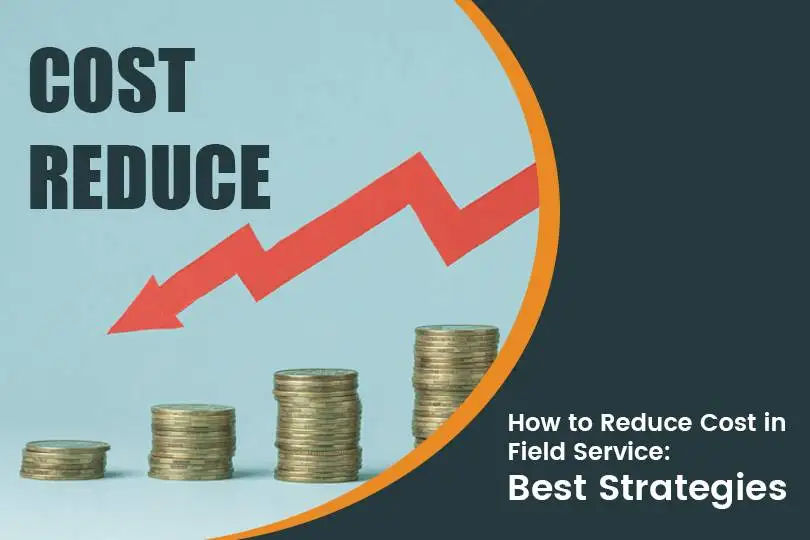How to Reduce Costs and Increase Profit: Top 7 Cost Reducing Strategies for Your Business

For small businesses, while increasing revenue is the big goal, minimizing your operating costs is a big part of ensuring your business is a success. It’s helpful to periodically review your overhead costs to ensure you’re achieving value for money with your essential expenditures. In order to reach that goal, you must put some effective cost reducing strategies in place for your business.
By improving processes and thinking creatively, you can reduce your costs, which in turn can help you manage pressures around cash flow. It needn’t be as painful an exercise as you imagine, although it will require some smart thinking. When you find ways to save money, all improvements increase the prospects of your business and leave you with more resources to reinvest.
Ready to get started with Field Promax?
Sign Up FreeIf you want to successfully reduce your costs, forget about finding a single idea that would radically change the cost structure of your organization or department, thereby solving your problem in one fell swoop. If such an idea existed, it would most likely entail so much risk that the organization would never be willing to implement it. Instead, you should plan to reach your goal with a combination of various actions.
To give you some ideas, we have curated some of the most effective cost reduction strategies. You can try them all or choose what fits your needs the best.
The Benefits of Cost Reduction
In a highly competitive business sector like field service businesses, the implementation of effective cost-reduction strategies holds paramount importance. By adopting a proactive approach to managing expenses, organizations can enhance their overall financial health and competitiveness. Efficient cost management not only ensures the optimization of resources but also enables businesses to maintain a lean and agile operational model. This, in turn, fosters resilience against economic uncertainties and market fluctuations.
Moreover, a focus on cost reduction allows companies to allocate resources strategically, invest in innovative technologies, and continuously improve service quality without compromising financial stability. In an era where efficiency and sustainability are key determinants of success, prudent cost-reduction strategies serve as a vital tool for ensuring long-term viability and success in the field service industry.
With that in mind, it is evident that cost-reduction is not just important, it is essential to maintain competitive advantage and ensure sustainability. However, there are more ways an effective cost reduction strategy can benefit your organization, for example:
Improved Profit Margins
Implementing cost reduction strategies directly contributes to higher profit margins, allowing field service businesses to generate more revenue from existing operations and investments.
Resource Optimization
By carefully managing costs, organizations can optimize the utilization of resources, such as manpower, equipment, and materials, ensuring that each asset contributes efficiently to service delivery.
Enhanced Cash Flow
Efficient cost management results in improved cash flow, providing businesses with greater financial flexibility to invest in strategic initiatives, meet operational needs, and navigate economic uncertainties.
Customer Value Proposition
Cost reduction strategies enable companies to offer competitive pricing without compromising service quality, enhance the overall value proposition for customers, and potentially attract new business.

Adaptability to Market Changes
A leaner cost structure enhances an organization’s ability to adapt to changes in the market, allowing for quick responses to shifts in customer demands, technological advancements, and regulatory requirements.
Employee Morale and Retention
When businesses effectively manage costs, they create a stable and sustainable work environment, positively impacting employee morale and increasing the likelihood of retaining skilled and experienced personnel.
Investment in Innovation
By freeing up financial resources through cost reduction, companies can allocate funds to research and development, fostering innovation in processes, technologies, and services, ultimately ensuring long-term relevance and success in the field service sector.
15 Effective Strategies for Cost Reduction
1. Make A Plan
Start with a clear, comprehensive plan. You need to evaluate where your business is now and where you want to take it in the future. A well-thought-out road map is essential to properly forecast expenses and provide for contingencies. For instance, if you intend to pursue a new market next year, you have to factor in the related expenses into your forecast.
2. Benchmark against Your Industry
Follow market best practices to develop your cost reduction strategies. Establish metrics that are meaningful to your business and comparable to those used by other companies in your industry. If you see that you’re spending more in certain categories, then drill down, investigate why, and take appropriate action to reduce those costs to industry norms.
3. Supplier Negotiations
Regularly negotiate with suppliers to secure better deals on parts, materials, and services, leveraging long-term relationships and bulk purchasing power to achieve cost savings.
4. Cross-Training Technicians
Cross-train technicians in multiple skills to enhance flexibility and reduce the need for specialized personnel, allowing for more efficient resource allocation and responsiveness to diverse tasks.
5. Employ a Flexible Workforce
Utilize a mix of full-time, part-time, and contract workers to adapt to fluctuating demand, avoiding unnecessary labor costs during slow periods and optimizing staffing levels during peak times.
6. Invest in Technology
The most effective cost reducing strategy in today’s time is to invest in new technologies. Explore new technologies that may help your business improve efficiency, increase productivity, and reduce costs. Technology allows us to save money and advance our businesses in ways that weren’t possible even five years ago. From remote collaboration and online payment services to open-source software and mobile applications, there are many ways you can reduce business costs with technology. For example, many companies are now using cloud computing systems as opposed to in-house hardware, which can be relatively expensive to buy and maintain.
Ready to get started with Field Promax?
Sign Up Free7. Predictive Maintenance
Utilize predictive maintenance software and IoT sensors to monitor equipment health in real-time, allowing for proactive maintenance and preventing costly unplanned downtime.
8. Outsource Non-Core Functions
Outsource non-core tasks like admin or technical services to reduce costs and focus on core functions. Gigster alternatives offer flexible, cost-effective access to skilled professionals without long-term commitments.
9. Energy Efficiency Initiatives
Implement energy-saving practices in the office and field, such as using energy-efficient vehicles, appliances, and lighting, to cut down on utility costs.
10. Get Strict on Fixed Costs
People tend to become complacent about fixed costs because they are generally recurrent and often reflect long-standing relationships with suppliers. But you should periodically test the market to see if you can get a better deal from competing suppliers.
11. Manage Variable Costs Efficiently
Look at your company’s past variable expenses and calculate what percentage of sales they represent. Historic percentages provide both a good indicator of potential future costs and a benchmark to use in keeping those costs in line with selling activity.

12. Outsourcing Non-Core Functions
Consider outsourcing non-core tasks, such as administrative functions or specific technical services, to reduce overhead costs and focus internal resources on core competencies.
13. Performance Analytics
Implement data analytics tools to track and analyze key performance indicators, enabling data-driven decision-making that identifies areas for improvement and cost reduction.
14. Promote Your Business Online
If you have yet to jump on the internet marketing bandwagon, you are missing the potential of fast-paced, high-result, low-cost marketing. This is one of the most effective, surefire ways to reduce costs, since it lets you leverage a plethora of promotional platforms completely free of charge (or at least, with a minimal investment), attracting a huge amount of attention than you could using traditional marketing campaigns. You can start with a business blog, social media marketing, or other online advertising and have the potential to see a relatively quick response with very minimal business costs.
15. Go Paperless
Of all cost reducing techniques, automation is perhaps the most efficient strategy to cut overhead costs in a business. Therefore, if you want to save money, ditch your pen and paper as soon as possible. The cost of paper, ink, mailing supplies, and postage may seem minimal at times, but it can add up to a large business expense. Going paperless by not printing unless necessary, transitioning to a digital invoice and bill payment system, and filing all important paperwork on your computer instead of a file cabinet can help you reduce some of the most common recurring business costs.
The best way to ditch traditional paper-based methods is to sign up for a paperless business solution. To explain, there are digital tools, like business apps and software solutions, that help you automate your business. With these tools, you can take care of all your business processes without leaving a paper trail.
How Do You Develop the Perfect Cost-Reduction Strategy for Your Business?

Crafting a business strategy can be a little tricky. What may work for other businesses may not be as fruitful for your business. On the other hand, you may not be able to afford a specific strategy, although it seems perfect for you. The strategies we have listed above are all proven to be effective. But not all are going to be perfectly suitable for you. So, how do you know what might work for your business?
Here is a guide:
1. Conduct a Comprehensive Cost Audit
Begin by conducting a thorough examination of your current expenses. Identify and categorize costs related to personnel, operations, technology, and supply chain. This detailed analysis forms the foundation for informed decision-making and targeted cost reduction.
2. Set Clear Objectives
Define clear and measurable objectives for your cost-reduction strategy. Whether aiming to increase profit margins, improve cash flow, or enhance resource efficiency, establishing specific goals provides a roadmap for implementation and evaluation.
3. Prioritize Cost Categories
Not all costs are created equal. Prioritize cost categories based on their impact on overall operations and strategic goals. Focus on areas that offer the most significant opportunities for savings without compromising essential functions or quality.
4. Embrace Technology
Leverage advanced technologies, such as data analytics and automation, to identify inefficiencies and streamline processes. Implementing cutting-edge solutions can enhance operational efficiency, reduce manual errors, and uncover hidden cost-saving opportunities.
5. Involve Cross-Functional Teams
Develop a collaborative approach by involving representatives from various departments. Cross-functional teams bring diverse perspectives, ensuring that cost-reduction initiatives align with the overall business strategy and do not inadvertently hinder other critical functions.
6. Negotiate with Suppliers
Forge strong partnerships with suppliers and negotiate favorable terms. Bulk purchasing, long-term contracts, and strategic alliances can often lead to better pricing, reducing the overall cost of goods and services.
7. Encourage Employee Involvement
Tap into the collective knowledge and expertise of your workforce. Encourage employees to contribute ideas for cost reduction, as they often possess valuable insights into operational inefficiencies and innovative solutions.
8. Monitor Key Performance Indicators (KPIs)
Establish key performance indicators to track the progress of your cost-reduction strategy. Regularly monitor and analyze KPIs to ensure that the implemented measures are achieving the desired outcomes and making a positive impact on the bottom line.
9. Foster a Culture of Continuous Improvement
Cultivate a culture that values continuous improvement. Instill in your team the mindset that cost reduction is an ongoing process, encouraging innovation and adaptability to changing market conditions.
10. Seek Professional Guidance
Consider seeking professional advice from consultants or financial experts specializing in cost management. Their external perspective and industry knowledge can provide valuable insights and recommendations tailored to your specific business challenges.
Final Thoughts
Ensuring resource cost reduction in your small business and creating processes that will cost you less money over time doesn’t have to take a lot of time or even a lot of effort. In many cases, it’s about making smarter choices when deciding where to put your small business funds. The choice, at the end of the day, shapes your cost reducing strategies and pushes you towards profitability,
In today’s competitive market, the smartest move you can make for your business growth is to invest in a paperless business solution, and your best choice in this regard is Field Promax, without a doubt. It is the most popular and pocket-friendly business management software that helps you significantly cut overhead costs, increase profitability, and boost productivity with no extra effort.
Thanks to its chock-full of efficient features and functionalities, Field Promax emerges as a powerful ally for businesses seeking to enhance cost efficiency in their daily operations. This comprehensive field service management software optimizes scheduling and dispatch, enabling businesses to minimize travel time, reduce fuel costs, and enhance overall resource utilization. With real-time tracking and automated job assignment features, Field Promax ensures that field technicians are efficiently deployed based on their skills, proximity, and availability. By streamlining these processes, businesses can significantly cut operational costs associated with inefficient resource allocation and manual task assignment. Moreover, the software’s mobile accessibility empowers field technicians to access schedules, update job statuses, and communicate seamlessly from the field, reducing the need for time-consuming administrative tasks and further contributing to cost reduction.
In addition to cost reduction, Field Promax plays a pivotal role in fostering revenue growth and sustainability. By improving the efficiency of field service operations, businesses can enhance customer satisfaction through quicker response times and more reliable service delivery. Satisfied customers are more likely to become repeat clients and advocates for the brand, contributing to increased revenue through customer loyalty and positive word-of-mouth referrals. The software’s robust reporting functionalities offer valuable insights into performance metrics, enabling businesses to identify areas for improvement, refine strategies, and make informed decisions that support long-term sustainability. Field Promax thus stands as a comprehensive solution that not only trims operational costs but also propels businesses toward revenue growth and sustainable success in the competitive field service industry.
So, what are you waiting for? Sign up for Field Promax and create endless cost saving opportunities as you move forward.
For more information, contact Field Promax
We're here to help you get started